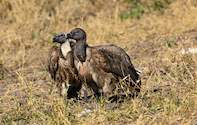

Only 330 Bearded Vultures were recorded in Southern Africa in September 2013, securing the rare bird's place on the list of critically endangered species. Sonja Krüger, an ecologist at Ezemvelo KZN Wildlife, explained the reason behind the low population numbers. "These extremely low numbers are mainly as a result of a lack of suitable habitat and food, as well as significant impacts through poisonings and collisions or electrocutions with powerlines," said Krüger.
In response to these low numbers, donations were funded to construct a hide for Bearded Vultures at one of KZN's world heritage sites - Cathedral Peak in the uKhahlamba Drakensberg Park. The site would act as a feeding site for the vultures and also create public awareness which would assist conservation efforts.
In 2013, however, a rise in Vulture deaths due to feeding on poisoned carcasses was beginning to worry conservationists. Fortunate enough, one of the poisoned Vultures was fitted with a tracking device, so it was able to find the location where the Vultures were under threat.
On the weekend of 22 - 23 November 2008, a team of conservationists fitted two bearded Vulture nestlings with satellite tracking devices. This is the first time that satellite tracking devices had been fitted to bearded Vulture chicks in Africa.
This exercise was part of the work of the Bearded Vulture Task Force of the Endangered Wildlife Trust, and formed part of an ongoing collaboration project between South Africa and Lesotho involving a range of role-players in the Maloti Drakensberg Mountains.
Researchers had hopes of determining the causes of mortality in young birds. "By knowing what their home range is, we can also mitigate potential threats within the home range. The aim is to reduce the mortality of young birds and halt the negative growth rate of the population and ultimately prevent extinction of this endangered bird," says ecologist Sonja Krüger of KZN Wildlife and chairperson of the Bearded Vulture Task Force of the Endangered Wildlife Trust's Birds of Prey Working Group.
The team consisted of the climbers David Allan of the Durban Museum, Charl Brummer of KZN Wildlife, a Swiss biologist who assisted in fitting the satellite transmitter, and raptor enthusiast Alan Howell of KZN Wildlife. The project is being coordinated by Krüger.
The team abseiled down to the nest, collected the chick and brought it to the top of the cliff. Several measurements were taken as well as blood samples for genetic analysis and gender determination.Each satellite transmitter was then fitted before the climber lowered the chick back onto the nest. In both cases the chicks went straight to the back of the nest and rested whilst the adults circled the nest making sure all was well. Both chicks looked in very good condition and were slightly heavier than the average for wild juvenile birds.Neither seemed perturbed about the satellite transmitter on their backs. These devices weigh 40 grams and transmit location information to satellites. This information is then downloaded to a website so that researchers can follow their movement patterns. These birds were expected to fledge in about two to three weeks' time. The negative impact of the exercise is assumed negligible but researchers kept an eye on the nests during the year and during the next breeding season.References
Wildlands Conservation Trusthttps://www.wildlands.co.za/news/new-vulture-hide-opens-in-the-ukhahlamba-drakensberg-park-at-cathedral-peak/
Vulture Conservation Foundation
https://www.4vultures.org/news/news-2013-2nd-half/

